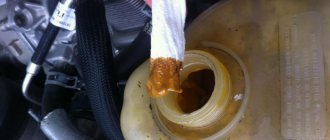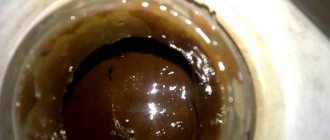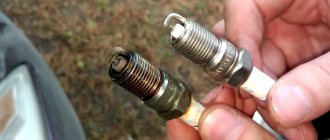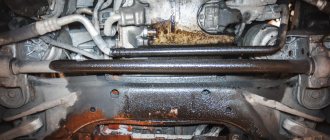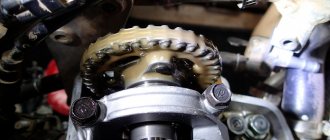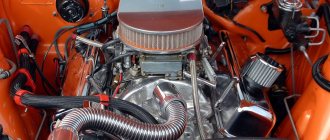01/25/2022 3 138 Cooling system
Author: Victor
The correct operation of a car engine depends on a number of factors, one of them is the circulation of engine fluid and antifreeze through the internal combustion engine and cooling system. Mixing of substances may be the result of a serious problem that will lead to inoperability of the unit. For what reasons does oil appear in antifreeze and how to solve the problem, you will learn from this article.
[Hide]
Reasons for oil getting into the cooling system
Oil in expansion tank with antifreeze
First, let's look at the reasons why motor lubricant got into the engine. They are relevant for all types of engines, diesel and gasoline, regardless of the make of the car, be it a VAZ, Mercedes or KamAZ. Both types of liquids circulate through closed, impermeable and isolated systems. Therefore, the appearance of a lubricant in the refrigerant indicates a malfunction. A violation of the tightness will lead to the inoperability of the power unit in the future.
The main reasons why oil went into antifreeze and ended up in the cooling system:
- violations of the integrity of the cylinder head gasket associated with wear or other problems;
- mechanical defects in the operation of the radiator or cooling device;
- water pump failure;
- damage or wear of the heat exchanger gasket;
- the appearance of a crack in the refrigerant container;
- natural wear or defect of cooling system hoses;
- rust formation on cylinder head liners.
Sometimes the reason why antifreeze can get into the lubricant lies in the inadequacy of the fluids used in the car. When the level of refrigerant in the system decreases, car owners often fill the tank with the first available coolant. Due to the different composition of liquids and additives in antifreeze, chemical reactions can occur that lead to the destruction of certain components of the internal combustion engine. These are the main reasons why oil can get into antifreeze.
You will learn more about the reasons for mixing substances from the video made by user Ruslan Yashchishin-KATMASTER.
Cracks in the oil cooler block
Physical damage to the heat exchanger is more difficult to repair. In most cases, you will have to purchase new parts, since argon welding is useless - soon cracks will form again and will require all fluids to be changed and repairs performed again.
But such breakdowns often occur only at very long mileage or during accidents in which there is a specific physical impact on the heat exchanger. In other cases, the oil cooler does not experience heavy loads.
How to determine?
Let's look at how to recognize and determine that lubricant is getting into the coolant.
The main signs indicating a problem:
- When the refrigerant is drained, the color and consistency are correct. But when all the liquid has drained into the container, a mixture of antifreeze and lubricant will come out of the hole, more viscous and oily in appearance. If you check the condition of the substance in the expansion tank, this may not be noticed.
- When mixing different chemical liquids, an oily film appears in the tank.
- The mixture will feel greasy to the touch and can be easily smeared with your fingers, but it will not leave any traces.
- The lubricant always burns. Therefore, if you take a rag or napkin and dip it into the reservoir under the hood, and then set it on fire, it will ignite. During combustion, a barely noticeable crackling sound will be heard. If you try to set fire to a piece of paper or a piece of cloth soaked in antifreeze, then nothing will work. And when performing this procedure with clean lubricant, the napkin will flare up quickly.
- When you open the filler cap, you will see that there are soot clots in the oil. In this case, there will be deposits in the channels of the lubrication system. This leads to a decrease in the throughput of the filter mechanism.
- When mixing, the filter itself becomes clogged with dense balls. The result is complete clogging of the device and abrasive wear of the cylinders, as well as bearings, crankshaft and camshaft.
- The appearance of corrosion inside the power unit. It is impossible to diagnose this problem without disassembling the engine.
- Reduced antifriction characteristics of engine oil.
- The film on the lubricant will be unstable, and at the slightest impact it will begin to tear.
The result of mixing coolant and lubricant
Filling with low-grade refrigerant or mixing antifreeze of different classifications
There are cases when a driver, noticing a low level of coolant in the tank, pours in the first available antifreeze. This should not be done under any circumstances! You cannot mix refrigerant that differs in composition and class.
There is a certain classification of refrigerants - g11,12,13, they all differ in cost and quality. Some people mistakenly think that you can mix antifreeze of the same color, but this is not true. The color of the coolant is given by the dye that manufacturers add there.
Additives added to antifreeze, when combining different types of antifreeze, may be incompatible and, when heated, enter into a chemical reaction, the consequences of which will be unpredictable.
Conclusion: use only products tested and recommended by car manufacturers.
Solution
Let's take a closer look at what to do if oil gets into the refrigerant.
If problems arise with mixing, the first thing to do is flush the cooling system.
If the reason lies in the appearance of defects on the cylinder head gasket, then you will have to remove the cylinder head and replace the damaged part. This procedure is best left to professionals.
What will you need?
To flush the cooling system you will need:
- new antifreeze that matches the parameters of the car;
- an old bucket or basin for collecting waste substances;
- approximately 15 liters of distillate;
- gasket for cooling device.
User Lesha Master showed on the video how to properly flush the system.
Step-by-step instruction
You need to clean the power unit as follows:
- If you have a special flushing agent, pour it into the expansion tank with coolant. Start the engine and wait until it warms up, this is required to start the radiator ventilation device. The flushing procedure is performed before replacing the oil cooler gasket.
- Unscrew the coolant drain plug, first placing a container under it into which the waste will flow. Wait until all the antifreeze has left the system.
- Remove the oil cooler. The dismantling procedure differs depending on the car, so we will not describe it. Before removal, study the service book to take into account all the nuances. After disassembly, clean the device. Worn gaskets and sealing components are removed and new ones are installed in their place. Parts are purchased taking into account the model and design features of the machine.
- After replacing the seals, remove the antifreeze reservoir located under the hood. Clean it, remove all deposits and dirt inside. If the container has cracks, it is recommended to replace it.
- After draining the old refrigerant and washing the tank, the cleaning process is performed another 2-3 times, depending on the amount of contamination. The reservoir is installed in place and the distillate is poured into it. The engine starts, but the heater must be turned off. Activate the radio, optics, interior lights and other energy consumers, this will allow the unit to reach operating temperature faster. As the engine heats up, the radiator fan will turn on. After this, turn off the power to all devices. Run the stove to maximum to cool the machine engine and turn off the ventilation device.
- Allow the unit to cool, this will take about 15 minutes. Open the drain plug and drain the distillate. If it is very dirty and has traces of deposits, wash it again. The procedure is repeated until the liquid draining from the cooling system is clean. The presence of traces of oil in the mining is not allowed.
- Screw the drain cap back into place and fill the system with new refrigerant. Antifreeze is selected in accordance with the technical parameters of the internal combustion engine. This may be G11, G12 or G13 standard fluid. Check in the service book; it usually contains the manufacturer's recommendations.
- Start the engine again and rev it up. By increasing the speed of the unit, press on the hoses of the cooling system, this will remove air. Please note that the expansion tank cap must be tightened when removing air plugs, but when pressing on the pipes, it should be opened from time to time.
Bent cylinder head
When overheated, engine parts can become deformed, creating additional problems for the car owner. For example, you may encounter that the plane of the block head will not be perfectly flat. A deviation of a few microns is enough to cause problems. In some places, peculiar cavities are formed, the head does not adhere well to the gasket, because of this, technical fluids begin to mix, forming an emulsion.
It is quite difficult to correct this situation. You need to remove the cylinder head and take it to the craftsmen for grinding. Of course, in this case, you should also inspect the valve system, grind the valves, inspect and possibly replace the valve seals, inspect the condition of the cylinder block and pay special attention to the condition of the oil scraper and compression rings. If they are already worn out, it is better to replace them immediately.
The block head is ground if the deformation is not too severe. Otherwise, you may need a new head or a used part from a donor.
Photo gallery
Photo on cleaning the cooling system of a car.
1. Remove the heat exchanger located next to the BC
2. Clean the device and replace the gasket
3. Remove the container and rinse it thoroughly
4. Clean the cooling system
Cars with intercooler
To increase the power of diesel engines, an intercooler is used - this is an additional cooler (radiator) located after the turbine. It is installed to cool the air entering the combustion chamber along with the fuel. If engine fluid gets on this element of the cooling system, it leads to a deterioration in the performance of the entire turbocharged system. Reasons for engine fluid getting on the radiator:
- Damage to the oil line located between the turbine and the crankcase of the power unit, which leads to an increase in pressure in the lubrication system - lubricant enters the intercooler.
- The appearance of cracks in the radiator housing. They can only be eliminated by welding.
- Wear of the air vent, formation of holes in it. There is a blockage in this element, which can be solved by cleaning the air vent.
- Malfunction of the oil filter. Replace the filter element with a new one.
- Crankcase ventilation failure. This problem is accompanied by an increase in the level of lubricant in the drive housing. The breakdown can only be repaired with a major overhaul of the power unit.
Most breakdowns of diesel engines that lead to disposal begin with the engine mixture getting into the coolant. It is possible to eliminate the cause of mixing consumables of the cooling and lubrication systems without spending a lot of money, but car enthusiasts ignore this problem - this leads to complete failure of the engine.
Consequences of mixing oil and antifreeze
If the oil goes into Antifreeze or another refrigerant, and the problem is not solved in a timely manner, this is fraught with the following consequences:
- Wear of bearing devices. Due to the mixing of liquids of different chemical compositions, corrosion occurs on the metal elements of the motor, and since all rubbing components, including bearings, are subject to high loads, this leads to rapid wear of parts.
- Motor jamming. This problem is more relevant for diesel units. As a result of mixing substances, rust forms on the internal walls of the internal combustion engine, which leads to damage. After using the car, when the engine cools down, some of the refrigerant may enter the combustion chamber. When the internal combustion engine is subsequently started, the coolant density will be reduced, which will lead to jamming of the unit and the need for expensive repairs.
- Clogged oil filter device. As a result of mixing additives of different compositions, soot appears and settles on engine elements. The filter becomes clogged with sediment particles and wear products, resulting in the need to replace it. But changing just the part itself is not enough; it is necessary to identify and eliminate damage through which the refrigerant enters the internal combustion engine. After this, the lubrication system is cleaned by flushing the engine. If you simply change the filter device and add new lubricant, the deposits will quickly clog the filter, and you will still have to completely solve the problem.
Is it possible to drive with oily antifreeze?
If signs of oil getting into the cooling system are detected, the car can be driven only to get home or the nearest service station. It is necessary to eliminate the identified malfunction as quickly as possible. Operating a car in which lubricant and antifreeze are mixed for a long time will lead to serious damage, so you need to act quickly to get out of the situation with minimal consequences and minimal expenditure of money.
To avoid such problems, if it is necessary to add antifreeze, you should use only the same liquid as has already been filled. It is necessary to monitor the technical condition of the car. If you find signs indicating that oil is entering the cooling system, you need to find the cause and eliminate it immediately. If you can’t do this yourself, you need to turn to specialists.
Video “Visual diagnosis of the problem”
You will learn what motor fluid mixed with refrigerant looks like and how the fault is diagnosed from the video filmed by the Mir Matizov channel.
Do you have any questions? Specialists and readers of the AUTODVIG website will help you ask a question
Was this article helpful?
Thank you for your opinion!
The article was useful. Please share the information with your friends.
Yes (100.00%)
No
X
Please write what is wrong and leave recommendations on the article
Cancel reply
Rate this article: ( 2 votes, average: 5.00 out of 5)
Discuss the article:
How to prevent a malfunction from occurring?
You can avoid breakdowns if you take into account tips and recommendations for using antifreeze. The very first rule is that you absolutely cannot add antifreeze to the tank if it is not compatible with the composition already used. It is imperative to follow all manufacturer’s recommendations regarding the materials used.
Masters advise regularly performing car maintenance work. You need to carefully monitor how the car behaves and what symptoms appear. When signs indicating a violation appear, it is necessary not to continue driving the car, but to begin repairs.
Since the repairs may require quite serious repairs, it is better to immediately contact knowledgeable people. Specialists will quickly find the leak and be able to determine the causes. The repair technicians will also be able to carry out repairs to a higher quality. The service station has the necessary equipment, and the room is suitable for repair work.
